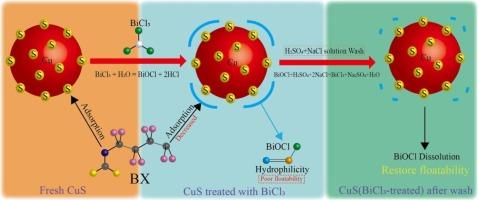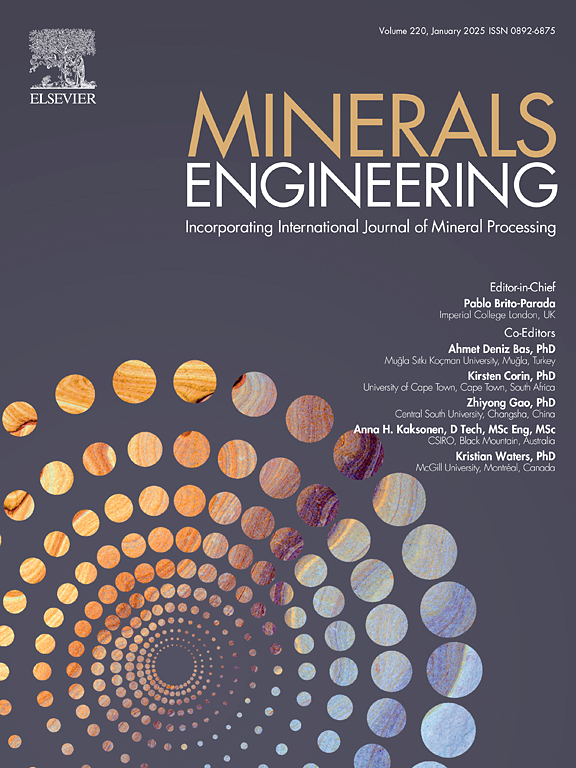Bi(III) 对铜冶炼粉尘浸出残渣中硫化铜浮选的影响
IF 4.9
2区 工程技术
Q1 ENGINEERING, CHEMICAL
引用次数: 0
摘要
浮选是从铜冶炼粉尘的酸浸渣中提取残余硫化铜(CuS)的一种潜在方法;然而,浮选矿浆中的铋(III)的抑制作用极大地阻碍了其实际应用。在本研究中,我们系统地研究了 Bi(III)对 CuS 浮选的抑制机理,并提出了一种防止抑制的方法。微浮选测试结果表明,pH 值为 3 且 Bi(III) 浓度大于 1 × 10-2 mol/L 的矿浆环境会显著降低 CuS 的可浮性。扫描电子显微镜和能量色散光谱结果证实,Bi(III)在 CuS 表面水解形成沉淀覆盖层,并吸附在 CuS 表面。经 X 射线光电子能谱分析和热力学计算证实,这种沉淀物就是 BiOCl。傅立叶变换红外分析表明,BiOCl 阻碍了黄原酸盐的吸附,从而降低了 CuS 的回收率。最后,用 H2SO4 + NaCl 溶液对浸出渣进行预处理,可以溶解 CuS 表面的 BiOCl 沉淀,消除 Bi(III)的影响,从而高效浮选回收浸出渣中的 CuS。本文章由计算机程序翻译,如有差异,请以英文原文为准。

Effect of Bi(III) on flotation of copper sulfide from leaching residue of copper smelting dust
Flotation is a potential method for extracting residual copper sulfide (CuS) from the acid-leaching residue of copper smelting dust; however, the inhibitory impact of Bi(III) in the flotation pulp significantly hampers its practical application. In this study, we systematically investigated the inhibition mechanism of Bi(III) on CuS flotation and propose a method to prevent inhibition. Microflotation test results show that a pulp environment with pH 3 and a Bi(III) concentration greater than 1 × 10–2 mol/L significantly depresses the floatability of CuS. Scanning electron microscopy and energy-dispersive spectroscopy results confirmed that Bi(III) hydrolyzes on the surface of CuS to form a precipitate cover layer, which adsorbs onto the surface of CuS. This precipitate was confirmed by X-ray photoelectron spectroscopy analysis and thermodynamic calculations to be BiOCl. Fourier transform infrared analysis revealed that BiOCl reduces the recovery of CuS by hindering the adsorption of xanthate. Finally, the pre-treatment of the leaching residue with H2SO4 + NaCl solution can dissolve BiOCl precipitates on the surface of CuS, eliminate the influence of Bi(III), and result in efficient flotation recovery of CuS from leaching residue.
求助全文
通过发布文献求助,成功后即可免费获取论文全文。
去求助
来源期刊

Minerals Engineering
工程技术-工程:化工
CiteScore
8.70
自引率
18.80%
发文量
519
审稿时长
81 days
期刊介绍:
The purpose of the journal is to provide for the rapid publication of topical papers featuring the latest developments in the allied fields of mineral processing and extractive metallurgy. Its wide ranging coverage of research and practical (operating) topics includes physical separation methods, such as comminution, flotation concentration and dewatering, chemical methods such as bio-, hydro-, and electro-metallurgy, analytical techniques, process control, simulation and instrumentation, and mineralogical aspects of processing. Environmental issues, particularly those pertaining to sustainable development, will also be strongly covered.
 求助内容:
求助内容: 应助结果提醒方式:
应助结果提醒方式:


